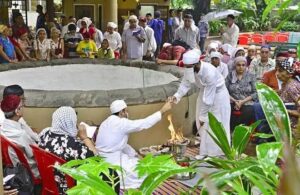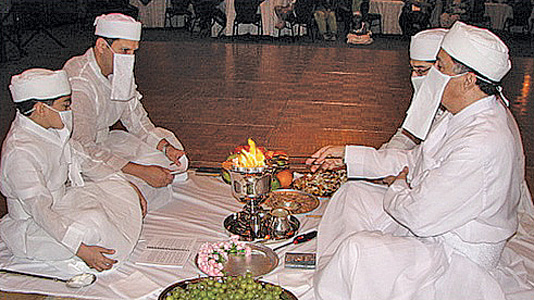During the holy month of Dae, we perform Jashan ceremonies by way of thanks-giving at home, at the workplace as also at various community centers and places of worship. Since Dae is dedicated to Ahura Mazda – the Supreme Divinity and Creator, it is considered particularly meritorious to perform Jashan as a ritual form of thanksgiving.
Act Of Worship: Colloquially or in ordinary conversation, Jashan means ‘rejoicing’ or an ‘assembly of rejoicing’. This is because the religious ceremony is usually followed by feasting and merriment among members of the family or the community. Jashan is a Pahlavi or Middle Persian term for the Avestan word Yasna which means ‘act of worship’.
The Jashan ceremony is an outer liturgical ceremony, which means a ceremony that can be performed at any clean place, unlike inner liturgical ceremonies which can only be performed at an Agyari or Atash Behram, in a specially consecrated area.
When Is Jashan Performed?
Several auspicious days and occasions are celebrated by performing the Jashan ceremony. For example, the monthly parabh or the day when the Amesha Spenta or Yazata of the day is the same as the month (i.e. Roj Ardibehesht Mah Ardibehesht or Roj Adar Mah Adar). Incidentally, the term parabh is derived from the Gujarati word parva which means festival.
Jashan ceremonies are also performed to celebrate the six Gahambars and to offer gratitude to Ahura Mazda for His six good creations, namely: the sky, water, earth, vegetation, animals and human beings. There is also the ‘Jashan of Sade’ to celebrate the discovery of fire and Jashan that is performed on ‘Zathosht-no-diso’ or the day when Asho Zarathushtra departed from this physical world.
Jashan ceremonies are also performed in memory or in honour of the fravashi of our dear departed. On happy occasions, like birthdays or weddings, Parsis also perform the Fareshta ceremony, which is a form of Jashan in honour of the Fareshtas or divinities.
Zot And Raspi: The Afringan is an important part of the Jashan ceremony, which is performed by one priest, called the Zaotar or Zot, meaning ‘one who offers’, who acts as the chief officiating priest, or, by a pair of priests, the Zot and his assistant, the Raspi. When three or more priests participate in an Afringan ceremony, it is called a Jashan, which then signifies an assembly of priests.
 The Zot usually faces East while performing the Afringan ceremony, but he may face any other direction except North. The Jashan tray is usually filled with a variety of seasonal fruits, especially the pomegranate, which is very essential. There is also a metal vase or Karasyo filled with fresh water, a glass of milk along with a glass of wine or rose-syrup, variety of flowers and a fire vase or Afarganyu. Every item in the tray is of ritual significance.
The Zot usually faces East while performing the Afringan ceremony, but he may face any other direction except North. The Jashan tray is usually filled with a variety of seasonal fruits, especially the pomegranate, which is very essential. There is also a metal vase or Karasyo filled with fresh water, a glass of milk along with a glass of wine or rose-syrup, variety of flowers and a fire vase or Afarganyu. Every item in the tray is of ritual significance.
The Jashan Ceremony: The Jashan ceremony proper is always preceded by the priests performing the Padyab-kushti (washing the hands, feet and face and untying and tying the sacred kushti around the waist). This is followed by the obligatory or Farziyat prayers and recital of the Atash Niyaesh or litany to the fire.
Fire is the dispeller of darkness and giver of life as also a purifying and healing force. Hence, by reciting the litany to fire, the priest invokes blessings for a long and healthy life filled with warmth and light. The priest then recites the Pazand Dua Nam Setayesh in praise of Ahura Mazda. After this, the priests exchange a ritual hand-clasp with the words: “hama-zor hama-asho bed” or “May we be united in spiritual strength, may we all be righteous in our actions.”
Eight flowers are also ceremonially arranged in the ritual tray and picked up, one by one, while reciting eight Yatha Ahu Vairyo, in honour the righteous fravashis which are invoked and invited to bless the ceremony. Flowers also represent Amardad or the spirit of immortality.
The Jashan ceremony is concluded with reciting the Tandorosti praying for the good health and prosperity of all those assembled.
Significance Of Seven Essentials Of Jashan
There is deep symbolic significance behind the essentials laid out at the Jashan ceremony. In fact, all the Seven Amesha Spenta or Divinities are represented. Ahura Mazda, the foremost Amesha Spenta is represented by the priest. Bahman is represented by the milk in the glass. Ardibehesht is represented by the ritual fire that is lit for the Jashan. Shehrevar is represented by the metal vase and Aspandarmad by the clean ground over which the Jashan ceremony is performed. Finally Khordad is represented by the fresh water and Amardad by the fresh flowers and fruits. Thus, starting with the Creator, all good creations of Ahura Mazda are recognized, celebrated and thanked during the Jashan ceremony.
The fruits are eaten as chasni or blessed food that is first offered to Divinity and then consumed by devotees. This concept is very similar to Hindu ‘prasad’.
Jashan is essentially a ritual form of expressing gratitude and invoking Divine Blessings. When performed with faith and understanding, it can foster strong bonds of family and community and lead to peace, unity, good health and prosperity for all.
- The Poison of Pessimism - 27 April2024
- Celebrating The Interplay Of Life And Fire! - 20 April2024
- Customs To Observe At Atash Behram Or Agyari - 13 April2024
